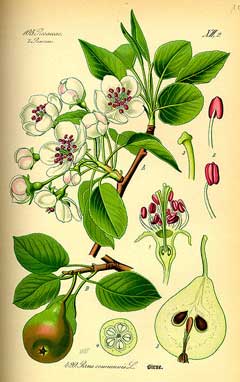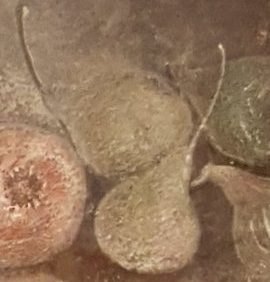
Native to Europe, this deciduous tree is a member of the rose family, Rosaceae, that also includes cherry, apple, and lady’s mantle. Although remains of pear have been found in European Neolithic and Bronze sites, the first evidence of pear cultivation comes from the works of the Greek and Roman writers, Theophrastus (d 387 BC), Cato the Elder (d. 149 BC), Varro (d. 27 BC) and Pliny the Elder (d. 79 AD). The ancient Roman naturalist, Pliny the Elder, identifies 41 varieties of pear and writes about various aspects of pear cultivation such as planting, grafting, bloom time, harvesting, storage, and uses, included those related to health. The frescoes in ancient Pompeii include a pear tree in the House of the Fruit Orchard and two pears with other fruit in the House of the Chaste Lovers. Photo Credit Wikimedia Commons

Description: Pear trees grow 40-50′ tall by 25-35′ wide, but are often grafted onto dwarf rootstalk to maintain a shorter size. The alternate green leaves are 1-4″ long, oval with serrated margins, and turn gold or yellow in the fall. Corymbs of saucer-shaped flowers appear in the spring. Each flower is 1-3″ wide, and has 4-5 white petals. The edible teardrop-shaped fruit varies in size, shape, and color depending on the variety. There are hundreds of varieties.
Size: 40-50’H x 25-35′ W
Light: Full sun; tolerates light shade
Soil: Average, medium moist, well-drained
USDA Hardiness Zones: 4-8